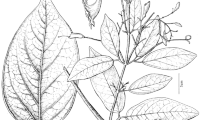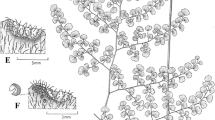Abstract
In the present study, the petiole anatomy of 39 species from tribes Cichorieae (18), Cardueae (10), Anthemideae (5), Inuleae (4), Gymnarrheneae (1), Astereae (1), and Gnaphalieae (1) was investigated to determine their taxonomic significance. Leica Light Microscope (Model 1000) embedded with the Infinity 1–5 C-MEL (Canada) digital camera was used to take the photomicrographs. Results revealed intra and interspecific variation. Among the examined traits, the significant systematic qualitative characteristics are petiole outline, arrangement and number of vascular bundles, shape and number of layers of different cells, and air spaces. The delimitation of taxa up to species level is carried via taxonomic key based on these qualitative traits. The quantitative data of length and width of the petiole, epidermal cells, chlorenchyma cells, parenchyma cells, vascular bundles, xylem vessels, and phloem cells, were statistically analyzed, collected into a matrix, and examined their significance in the species separation. Variations were observed in the petiole and vascular bundle size on the multivariate ordination of principal components. The highest positive correlation (0.87 – 0.98) is found in xylem vessels length and width with phloem cells length and width. The least positive correlation (0.07) was between vascular bundle length with xylem vessels and phloem cells. The two-way dendrogram on neighbor-joining clustering in multivariate analysis summarized that the selected quantitative traits are significant in distinguishing the examined species. Conclusively petiole anatomical traits are significant diagnostic tools that assist the separation of Asteraceous taxa.














Similar content being viewed by others
Data availability
All data is present in the paper.
Abbreviations
- NARC:
-
National Agricultural Research Centre
- ISL:
-
Islamabad
- QAU:
-
Quaid e Azam University
- DPX:
-
Dibutylphthalate Polystyrene Xylene
- UPGMA:
-
Un-weighted Pair Group Clustering Method
- PCA:
-
Principal Component Analysis
- SEM:
-
Scanning Electron Microscopy
- PCs:
-
Principal Components
References
Adedeji O, Jewoola OA (2008) Importance of leaf epidermal characters in the Asteraceae family. Not Bot Horti Agrobo 36(2):7–16
Akhtar A, Ahmad M, Mahmood T, Khan AM, Arfan M, Abbas Q, Khan A (2022) Microscopic characterization of petiole anatomy of Asteraceous taxa of Western Himalaya-Pakistan. Microsc Res Tech 85(2):591–606
Al-Suboh KI, Al-Khesraji TO, Al-Assie AH (2019) Comparative anatomical study of three Centaurea species (Asteraceae) from Iraq. Plant Arch 19(2):3404–3410
Bahadur S, Rehman S, Long W, Ahmad M, Ullah F, Butt MA (2023) Foliar micromorphology with emphasis on the trichomes diversity and its taxonomic relevance in selected tribes of Asteraceae from Hainan Island. Flora 300(152229):1–18
Bercu R, Popoviciu DR (2014) Anatomical study of Ficus carica L leaf. Ann Romanian Soc Cell Biol 19(1):33–37
Bibi T, Ahmad M, Tareen NM, Jabeen R, Sultana S, Zafar M, Zain-ul-Abidin S (2015) The endemic medicinal plants of Northern Balochistan, Pakistan and their uses in traditional medicine. J Ethnopharmacol 173:1–10
De Micco V, Aronne G (2012). Morpho-anatomical traits for plant adaptation to drought. In: Plant responses to drought stress: From morphological to molecular features 37–61.
De las Mercedes Sosa M, via do Pico GM, Dematteis M (2014). Comparative anatomy of leaves and stems in some species of the South American genus Chrysolaena (Vernonieae, Asteraceae) and taxonomic implications. Nord, J Bot, 32 (5), 611-619
Ekeke C, Ogazie CA (2020) Systematic significance of petiole anatomical characteristics in some members of Asteraceae from some parts of Nigeria. SJSR 10(4):387–399
Faisal TR, Rey AD, Pasini D (2012) Hierarchical microstructure and elastic properties of leaf petiole tissue in philodendron melinonii. MRS Online Proc Library (OPL) 1420:11–1420
Filartiga AL, Klimeš A, Altman J, Nobis MP, Crivellaro A, Schweingruber F, Doležal J (2022) Comparative anatomy of leaf petioles in temperate trees and shrubs: the role of plant size, environment and phylogeny. Ann Bot 129(5):567–582
Hameed A, Zafar M, Ahmad M, Sultana S, Bahadur S, Anjum F, Altaf MA (2021) Chemo-taxonomic and biological potential of highly therapeutic plant Pedicularis groenlandica Retz. Using multiple microscopic techniques. Microscop Res Tech 84(12):2890–2905
Jan PS, Sadia B, Yousaf A, Naz N, Rehmat N, Tahira B, Bazai ZA (2021) Ethnobotanical study of flora of Gulistan, district Killa Abdullah, Balochistan. Pakistan Pure Appl Biol 5:361–368
Janaćković P, Gavrilović M, Rančić D, Dajić-Stevanović Z, Giweli AA, Marin PD (2019) Comparative anatomical investigation of five Artemisia L. (Anthemideae, Asteraceae) species in view of taxonomy. Rev Bras Bot 42:135–147
Janaćković P, Gavrilović M, Rančić D, Stešević D, Dajić-Stevanović Z, Marin PD (2021) Anatomical traits of Artemisia umbelliformis subsp. eriantha (Asteraceae) alpine glacial relict from Mt. Durmitor (Montenegro). Bot Serb 45(1):23–30
Jušković MŽ, Vasiljević PJ, Savić AV, Jenačković DD, Stevanović BM (2017) Comparative morphoanatomical analysis of the leaves and stems of Daphne (Thymelaeaceae) species. Biologia 72(7):709–721
Kamel EA, Loutfy MHA (2001) The significance of cuticular features, petiole anatomy and SDS-PAGE in the taxonomy of the Lauraceae. Pak J Biol Sci 4(9):1094–1100
Karaismailoğlu C (2021) Petiole anatomy of 21 representatives of Tribe Alysseae (Brassicaceae) from Turkey. Kahramanmaraş Sütçü İmam Üniversitesi Tarım Ve Doğa Dergisi 23(6):1535–1544
Khan MZ, Ghalib SA, Zehra A, Hussain B (2021) Bioecology and conservation of the birds of Hingol National Park. Balochistan J Basic Appl Sci 6(2):175–184
Kim K, Labbé N, Warren JM, Elder T, Rials TG (2015) Chemical and anatomical changes in Liquidambar styraciflua L. xylem after long term exposure to elevated CO2. Environ Pollut 198:179–185
Levionnois S, Coste S, Nicolini E, Stahl C, Morel H, Heuret P (2020) Scaling of petiole anatomies, mechanics and vasculatures with leaf size in the widespread Neotropical pioneer tree species Cecropia obtusa Trécul (Urticaceae). Tree Physiol 40(2):245–258
Łotocka B, Geszprych A (2004) Anatomy of the vegetative organs and secretory structures of Rhaponticum carthamoides (Asteraceae). Bot J Linn Soc 144(2):207–233
Mabel AF, Johnson AA, Temitope OO (2013) Petiole anatomy of some species of Asteraceae in southwest Nigeria. Afr J Plant Sci 7(12):608–612
Majeed S, Zafar M, Althobaiti AT, Ramadan MF, Ahmad M, Makhkamov T, Yaseen G (2022) Comparative petiole histology using microscopic imaging visualization among Amaranthaceous taxa. Flora 297:152178
Melo-de-pinna GF, Menezes NL (2002) Vegetative organ anatomy of Ianthopappus corymbosus Roque & Hind (Asteraceae-Mutisieae). Rev Bras Bot 25:505–514
Metcalfe CR, Chalk L (1979). Anatomy of the dicotyledons. Oxford: Clarendon Press VI 276 p.
Noor W, Zafar M, Ahmad M, Althobaiti AT, Ramadan MF, Makhkamov T, Bibi S, Khan A (2023) Petiole micromorphology in Brassicaceous taxa and its potential for accurate taxonomic identification. Flora 303:152280
Noraini T, Ruzi AR, Ismail BS, Hani BU, Salwa S, Azeyanty JA (2016) Petiole vascular bundles and its taxonomic value in the tribe Dipterocarpeae (Dipterocarpaceae). Sains Malays 45(2):247–253
Nurul-Aini CAC, Noraini T, Latiff A, Chung RCK, Nurhanim MN, Ruzi M (2013) Systematic significance of petiole anatomical characteristics in Microcos L.(Malvaceae: Grewioideae). Malaya Nat J 65(2&3):145–170
Özcan M, Ünver MC, Eminağaoğlu Ö (2014) Comparative anatomical and ecological investigations on some Centaurea (Asteraceae) taxa from Turkey and their taxonomic significance. Pak J Bot 46(4):1287–1301
Qureshi SJ, Khan MA, Arshad M, Rashid A, Ahmad M (2009) Pollen fertility (viability) status in Asteraceae species of Pakistan. Trakia J Sci 7:12–16
Rabiae E, Elbadry SH (2020). Morphology, anatomy, palynology and seed micromorphology of Libyan Endemic Bellis sylvestrisvar. Cyrenaica (Asteraceae). IJPC 46–50.
Rashid ZSA, Amri CNAC, Shahari R (2022) Leaf anatomy of the medicinal plant Sphagneticola trilobata (L.) Pruski. J Sustain Sci Manage 17(3):114–131
Tekin M, Kartal C (2016) Comparative anatomical investigations on six endemic Tanacetum (Asteraceae) taxa from Turkey. Pak J Bot 48(4):1501–1515
Uga Y, Ebana K, Abe J, Morita S, Okuno K, Yano M (2009) Variation in root morphology and anatomy among accessions of cultivated rice (Oryza sativa L.) with different genetic backgrounds. Breed Sci 59(1):87–93
Acknowledgements
This work is from the PhD work of the first author and the authors are the thankful to Department of Plant Sciences for providing facilities for this research.
Funding
No funding.
Author information
Authors and Affiliations
Contributions
BS and MA Conceptualized study. BS, SWG, MM, MZ and WN data collection. BS, SWG, SS, writing the original draft. MA and MZ review and editing. MA Supervised the study.
Corresponding authors
Ethics declarations
Conflict of interest
The authors declare that they have no competing interest.
Consent for Publication
All authors read the research paper and approved it for publication.
Ethical approval
Verbal prior informal information consent was obtained before survey.
Additional information
Publisher's Note
Springer Nature remains neutral with regard to jurisdictional claims in published maps and institutional affiliations.
Supplementary Information
Below is the link to the electronic supplementary material.
Rights and permissions
Springer Nature or its licensor (e.g. a society or other partner) holds exclusive rights to this article under a publishing agreement with the author(s) or other rightsholder(s); author self-archiving of the accepted manuscript version of this article is solely governed by the terms of such publishing agreement and applicable law.
About this article
Cite this article
Sadia, B., Ahmad, M., Zafar, M. et al. Taxonomic implications of petiole microanatomical traits among Asteraceae tribes from arid–semiarid regions of Baluchistan, Pakistan. Genet Resour Crop Evol (2024). https://doi.org/10.1007/s10722-024-01984-7
Received:
Accepted:
Published:
DOI: https://doi.org/10.1007/s10722-024-01984-7




